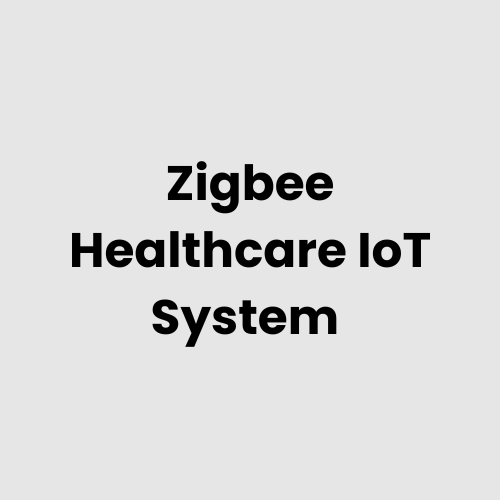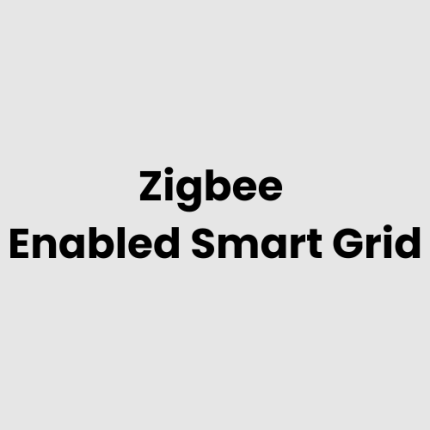Description
Technical Architecture of Zigbee Enabled Healthcare IoT System
The Zigbee Enabled Healthcare IoT System connects smart devices using a robust, low-power mesh network. The system architecture includes the following layers:
- Device Layer: IoT devices such as smart plugs, lights, and sensors embedded with Zigbee modules.
- Communication Layer: Zigbee-based wireless mesh network ensuring seamless data exchange between devices.
- Edge Layer: Gateways aggregating device data and enabling local processing for real-time decisions.
- Cloud Integration Layer: Secure transmission of data to cloud platforms for analytics and remote control.
- User Interface Layer: Mobile or web applications providing a user-friendly interface for monitoring and control.
Hardware of Zigbee Enabled Healthcare IoT System
- Zigbee-enabled IoT Devices: Smart thermostats, light bulbs, plugs, and security sensors.
- Gateways and Hubs: Central units connecting the Zigbee network to the internet.
- Edge Computing Modules: Embedded processors for real-time decision-making at the local level.
- Power Management Units: Batteries or energy harvesting modules for low-power devices.
- Network Routers: Extenders to strengthen the mesh network.
Physical Placement Considerations
- Smart Devices: Install within range of the Zigbee mesh for consistent communication, avoiding obstructions like thick walls.
- Gateways: Place centrally to ensure robust connection between the Zigbee network and cloud services.
- Routers: Strategically position in areas with potential signal drop-offs to enhance network stability.
- Sensors: Align based on function—motion sensors near entrances, temperature sensors in climate-sensitive zones, etc.
Hardware Architecture of Zigbee Enabled Healthcare IoT System
The hardware architecture integrates key components, including Zigbee modules for connectivity, low-power microcontrollers, and sensors tailored for specific applications. Power-efficient designs ensure prolonged battery life, while modular hubs enable seamless scalability.
Deployment Considerations
- Scalability: Design the network to accommodate additional devices without impacting performance.
- Interoperability: Ensure compatibility with existing IoT ecosystems and protocols.
- Network Security: Implement encrypted communication to safeguard user data.
- Device Pairing: Simplify installation with QR codes or automated pairing processes.
- User Training: Provide user-friendly guides for seamless adoption.
Relevant Industry Standards and Regulations
- IEEE 802.15.4
- Zigbee 3.0
- ISO/IEC 27001
- NIST Cybersecurity Framework
- FCC Part 15
- ETSI EN 300 328
- UL 2900
- GDPR (for European deployments)
- ANSI C12.20
- CSA Group Standards
Local Server Version
The local server version of the Zigbee Enabled Healthcare IoT System provides data processing and device control without internet dependency. It uses a standalone Zigbee hub integrated with edge computing capabilities. This setup is ideal for high-security environments or regions with limited connectivity.
Cloud Integration and Data Management
Zigbee-enabled systems leverage cloud platforms for advanced analytics, remote device control, and real-time monitoring. Encrypted protocols ensure data security during transmission, while multi-tenant cloud architectures offer scalability. Integration with platforms like AWS IoT or Azure IoT Hub enhances predictive maintenance and device interoperability. GAO Tek’s expertise ensures seamless implementation of cloud-connected IoT ecosystems.
GAO Tek Inc., headquartered in New York City and Toronto, offers a comprehensive range of Zigbee-enabled IoT solutions designed for efficiency, reliability, and scalability. With our extensive R&D investments, GAO delivers cutting-edge products tailored to diverse Healthcare needs, backed by stringent quality assurance and expert support services.
GAO Case Studies of Zigbee Enabled Healthcare IoT System
Case Studies in the USA
- San Francisco, California
In San Francisco, a Zigbee-enabled IoT network was deployed in residential buildings to integrate smart lighting, energy meters, and automated window blinds. This system optimized energy consumption by analyzing user behavior and environmental conditions. The deployment demonstrated enhanced energy efficiency and user convenience, showcasing the scalability of Zigbee-based solutions in urban housing. - Austin, Texas
A suburban neighborhood in Austin implemented a Zigbee-enabled IoT system to connect smart thermostats, outdoor irrigation controllers, and security sensors. The solution offered real-time monitoring and automated climate control, leading to water and energy conservation and improved home security. - Seattle, Washington
In Seattle, Zigbee technology was utilized to create a smart home network that linked motion detectors, door locks, and lighting systems. The mesh network allowed for seamless remote management and robust security, reducing homeowners’ concerns about safety and energy wastage. - New York City, New York
A high-rise in New York City integrated Zigbee-enabled devices, including air quality sensors and appliance controllers. This system optimized air circulation and energy usage, providing residents with a healthier and more efficient living environment. - Miami, Florida
In Miami, a coastal community adopted a Zigbee IoT solution for flood sensors, smart pumps, and weather monitoring. The system proactively addressed flooding risks while automating irrigation based on real-time weather data, significantly reducing property damage and water wastage. - Chicago, Illinois
An urban housing complex in Chicago deployed Zigbee-enabled water heaters, energy monitors, and smart plugs. The system minimized power consumption during peak hours and provided data-driven insights to optimize utility usage across the complex. - Denver, Colorado
A smart residential project in Denver implemented Zigbee technology to manage home security cameras, window sensors, and lighting automation. The system allowed seamless integration with voice assistants, enhancing accessibility for diverse user groups. - Boston, Massachusetts
In Boston, smart energy meters and thermostat controllers were interconnected using Zigbee IoT systems in a housing project. This integration enabled personalized energy-saving recommendations, empowering users to actively reduce their carbon footprint. - Phoenix, Arizona
A Zigbee-based system in Phoenix linked air conditioning units, pool pumps, and automated shades to tackle the challenges of extreme heat. This deployment significantly reduced energy costs and enhanced indoor comfort for residents. - Las Vegas, Nevada
In Las Vegas, smart home automation using Zigbee networks integrated lighting, HVAC systems, and door locks. The system improved energy efficiency and provided remote access for tourists renting homes, offering flexibility and security. - Minneapolis, Minnesota
A suburban development in Minneapolis implemented Zigbee IoT to manage indoor and outdoor lighting systems, leveraging motion sensors for energy conservation. The system proved highly effective in minimizing power consumption during nighttime hours. - Atlanta, Georgia
In Atlanta, smart door locks, smoke detectors, and video doorbells were interconnected via Zigbee in a gated community. This network enhanced safety by providing real-time alerts to homeowners and local emergency services. - Portland, Oregon
Portland’s urban housing initiative included a Zigbee-based solution for appliance automation and indoor climate monitoring. The system provided data on indoor air quality and enabled sustainable energy use during peak demand. - Dallas, Texas
A smart IoT deployment in Dallas incorporated Zigbee-enabled lawn irrigation systems and environmental sensors. The solution utilized weather forecasts to minimize water consumption while maintaining landscaping quality. - Los Angeles, California
Los Angeles homes adopted Zigbee-enabled security and entertainment systems. The network synchronized streaming devices, smart speakers, and surveillance cameras, delivering convenience and safety within a unified system.
Case Studies in Canada
- Toronto, Ontario
A residential project in Toronto deployed a Zigbee-based IoT system to integrate lighting, air quality monitors, and automated blinds. This system showcased the ability of Zigbee networks to provide efficient and environmentally friendly solutions for densely populated urban areas. - Vancouver, British Columbia
In Vancouver, a Zigbee-enabled home automation network was installed to manage smart thermostats, irrigation systems, and energy meters. The system achieved significant energy savings and facilitated sustainable living practices in a suburban setting.
GAO Tek Inc., with headquarters in New York City and Toronto, is proud to support such innovative deployments with our advanced technologies. We ensure these projects meet stringent quality and scalability standards, helping create smarter, more connected communities. Visit GAO Tek for tailored Zigbee IoT solutions.
Navigation Menu for Zigbee
- Zigbee Gateways/Hubs
- Zigbee End Devices
- ZigBee – Cloud, Server, PC & Mobile Systems
- Zigbee Accessories
Navigation Menu for IoT
- LORAWAN
- ZIGBEE
- Wi-Fi HaLow
- Z-WAVE
- BLE & RFID
- NB-IOT
- CELLULAR IOT
- GPS IOT
- IOT SENSORS
- EDGE COMPUTING
- IOT SYSTEMS
Our products are in stock and can be shipped anywhere in the continental U.S. or Canada from our local warehouse. For any further information, please fill out this form or email us.
We are actively looking for partners who are like us located in the U.S. and Canada. For more information on partnering with GAO, please visit Partner with GAO Tek Inc. It lists various ways to partner with GAO, such as OEM Partnerships, Technology Integration, Distribution and Reselling Opportunities, Presenting at the Leading Event Tek Summit, Joint R&D Projects, Training and Consulting Services, Industry-Specific Collaborations, Research and Academic Partnerships.



